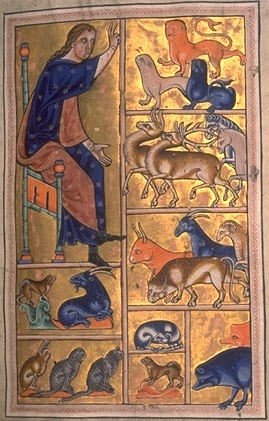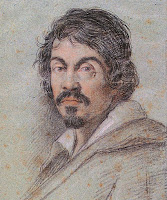Where the Wild Things Are
 |
| Adam names the animals |
The sky is overcast
with dark grey clouds and the persistent drizzle is quickly turning into a downpour. It is
the twelfth century in England and Emily is sitting next to her father,
watching him work. At sixteen, she is already quite an accomplished artist and considers
herself very fortunate to be the daughter of one of the most talented and
respected illuminators in England. Her father is creating an ‘Illuminated
Manuscript’. Emily knows the patron is extremely wealthy and suspects he may be
from the royal family.
Illuminated manuscripts were manuscripts decorated in real
gold or silver and were fairly common in the medieval ages. They were painted
on the best quality parchment called 'Vellum' and were written in Latin. The text
was usually written first by a scribe and then given to the illuminator. Emily
watches her father as he applies the gold to the painting. She knows the
complex process well by now, the gold leaf pieces are hammered until they are,
‘thinner than the thinnest paper’ then they are mixed with stag’s glue and put
into water and mixed with your finger. Once the gold is soft and malleable in
the water it is ready to be applied on the page. Sometimes gold powder was also
used. Apart from gold and silver the artists also used insect based colours,
chemical and mineral based colours and plant based colours.
The illuminated manuscript that Emily’s father is creating a Bestiary. A bestiary is quite
simply a book of beasts; it is a collection of short descriptions about all
sorts of animals real and imaginary, accompanied by a moralising explanation.
Although it deals with the natural world it was never meant to be a scientific
text. This particular book came to be known as the ‘Aberdeen Bestiary’ and is
considered one of the best examples of its type.
As the rain lashes on the window, Emily gathers the completed
pages of the manuscript and stacks them together, she marvels at their beauty.
Each picture is set in a frame with a background of burnished gold. The colours
are rich and bold, with blues and reds dominating each composition. The
rhythmically graceful black outline brings each figure to life.
Apes: The female ape gives birth to twins.
She loves one but hates the other. When hunted she carries the loved one in her
arms, while the other clings to her back. Eventually she gets tired and drops
the favoured baby and the other one is saved.

The Panther: A many coloured animal the panther is handsome and gentle, his only enemy is the dragon. When the panther roars, he exhales a sweet odour which draws all the other animals to him except the dragon, who retreats into his hole, stiffens with fear, and pretends to be dead.
The Fox: The fox is crafty and deceitful. When he is hungry he rolls in red earth to look like he’s covered in blood. He feigns death by holding his breath, and when birds come to sit on his body he jumps up and eats them.

Dogs: Dogs are the most generously illustrated, with three sets of illuminations. Here three attentive dogs are shown with collars and leads. They are the most intelligent of all animals and are devoted to humans. They track down wild beasts, guard sheep and protect property.
Emily apprenticed under her father and became an accomplished illuminator; as did a lot of women in this period especially in Paris. The Aberdeen Bestiary became a part of Henry VIII’s private collection. It was never fully completed and has notes on the process of its execution in the margins. It would be approximately nine hundred years later, that the magical beasts from the famous Harry Potter series which have fascinated us all, would be inspired from these very medieval bestiaries.
References:
Aberdeen Bestiary




Comments
Post a Comment